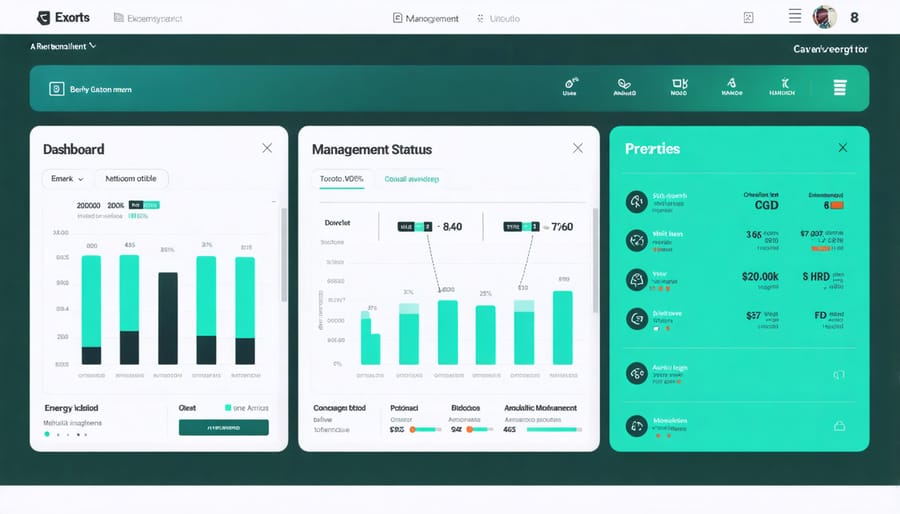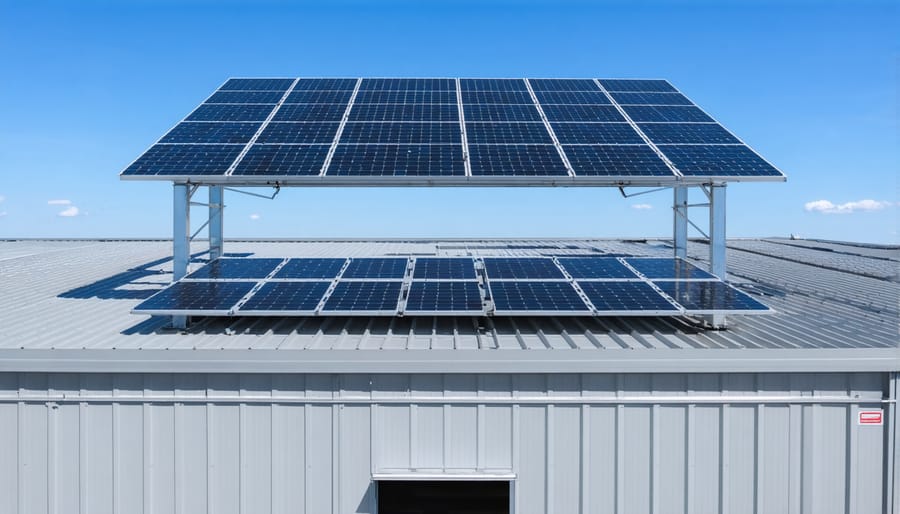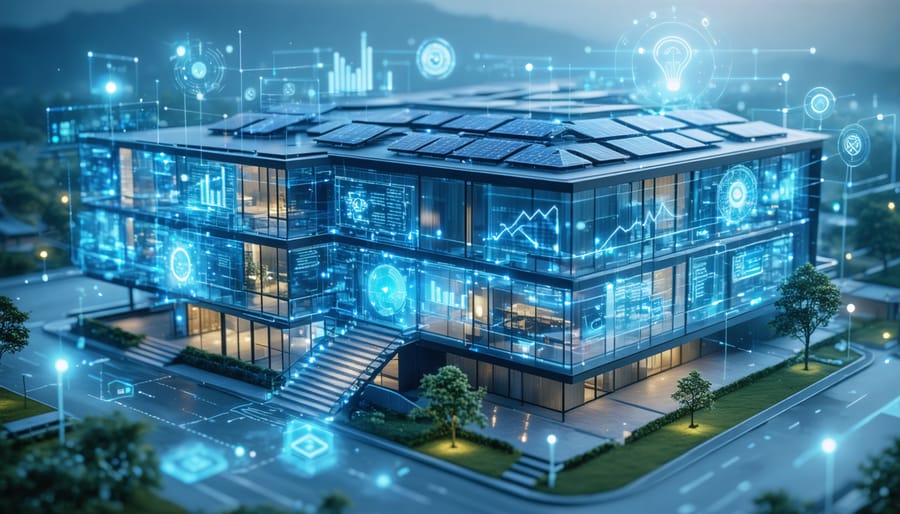Transform your commercial building into an energy-efficient powerhouse while slashing operational costs by up to 30% through modern energy management systems (EMS). Today’s intelligent building solutions combine AI-driven analytics, real-time monitoring, and automated controls to optimize every aspect of energy consumption – from HVAC and lighting to plug loads and renewable energy integration.
Leading Australian businesses are already demonstrating the remarkable potential of advanced EMS implementations. The Melbourne Central Tower reduced its annual energy expenditure by $450,000 through smart building technology, while Sydney’s International Towers achieved a 6-star Green Star rating by leveraging comprehensive energy management solutions.
For facility managers and building owners, the path to energy efficiency has never been clearer. Modern EMS platforms offer unprecedented visibility into energy usage patterns, predictive maintenance capabilities, and automated optimization strategies that deliver both immediate cost savings and long-term sustainability benefits. With energy prices continuing to rise and environmental regulations tightening, implementing a robust EMS isn’t just an option – it’s a competitive necessity for future-focused commercial properties.
Let’s explore how today’s cutting-edge energy management systems are revolutionizing commercial building operations and delivering measurable returns on investment.
The Smart Building Revolution in Australia
Key Components of Modern Energy Management Systems
Modern energy management systems rely on several interconnected technologies working in harmony to optimize building performance. At the heart of these systems are smart meters and sensors that continuously monitor energy consumption, temperature, occupancy, and lighting levels in real-time. These devices feed data into a central Building Management System (BMS) that serves as the brain of the operation.
Advanced analytics platforms process this information using artificial intelligence and machine learning algorithms to identify patterns, predict usage trends, and spot inefficiencies. Building operators can access these insights through user-friendly dashboards that display key performance indicators and actionable recommendations.
Automated control systems form another crucial component, managing HVAC, lighting, and other building systems to maintain optimal conditions while minimizing energy waste. These systems can adjust settings automatically based on occupancy patterns, weather conditions, and time of day.
Integration capabilities are equally important, allowing the system to communicate with renewable energy sources, energy storage systems, and the power grid. This enables smart load management and helps buildings participate in demand response programs, contributing to both cost savings and grid stability.
Real-Time Monitoring and Analytics
Modern commercial buildings are becoming increasingly intelligent thanks to advanced sensor networks and real-time analytics platforms. These systems work around the clock, collecting vital data about energy consumption patterns, occupancy levels, and environmental conditions. Smart sensors strategically placed throughout the building monitor everything from temperature and humidity to lighting levels and equipment performance.
The real power lies in how this data is processed and analysed. Advanced analytics platforms use machine learning algorithms to identify energy waste, predict maintenance needs, and automatically adjust building systems for optimal performance. For instance, a Melbourne office building reduced its energy consumption by 25% after implementing smart monitoring solutions that detected and corrected inefficient HVAC operation patterns.
Building managers can access intuitive dashboards that display real-time energy usage, cost metrics, and sustainability indicators. These platforms enable quick decision-making and provide actionable insights through automated alerts and detailed reports. The system might notify staff when energy usage spikes unexpectedly or suggest optimal times for running energy-intensive operations based on occupancy patterns and weather forecasts.
This data-driven approach ensures that energy efficiency isn’t just a one-time achievement but a continuous improvement process.


Integration with Renewable Energy Sources
Solar and Bioenergy Integration
The integration of solar power and bioenergy presents a game-changing opportunity for commercial buildings in Australia. By combining these complementary renewable sources, businesses can create more resilient and sustainable energy systems that operate around the clock. Solar panels harness abundant daylight hours, while innovative urban waste-to-energy solutions provide consistent baseline power, especially during evening peaks or cloudy days.
Success stories across the country demonstrate the effectiveness of this dual approach. The Melbourne Convention Centre, for instance, combines rooftop solar arrays with an on-site biomass digester, converting food waste into usable energy. This hybrid system has reduced their grid dependency by 40% while turning waste management into an energy asset.
Smart integration strategies typically involve advanced control systems that automatically switch between energy sources based on availability and demand. Energy storage solutions, such as batteries or thermal storage, bridge the gap between solar generation and bioenergy production, ensuring smooth operation throughout the day.
For building managers considering this approach, starting with a comprehensive energy audit helps identify the optimal mix of solar and bioenergy technologies. Many facilities begin with solar installation and gradually incorporate bioenergy systems as their needs grow. This staged approach allows for better cost management while moving steadily toward energy independence.
Energy Storage Solutions
Modern energy storage solutions are revolutionising how commercial buildings manage their power consumption and sustainability goals. Battery storage systems, particularly lithium-ion technologies, have become increasingly affordable and efficient, enabling businesses to store excess energy generated during off-peak periods for use during high-demand times.
These storage solutions work seamlessly with urban microgrid systems and renewable energy sources, creating a robust energy management ecosystem. Advanced thermal storage systems, including phase change materials and ice storage, are gaining traction in Australian commercial buildings, particularly for managing cooling loads during scorching summer days.
The integration of smart battery management systems allows facility managers to optimise energy use based on real-time pricing and demand patterns. For instance, the Melbourne CBD’s Premier Tower utilises a cutting-edge storage system that reduced their peak demand charges by 45% within the first year of implementation.
Emerging technologies like flow batteries and hydrogen storage systems are showing promise for long-duration storage needs. These solutions are particularly valuable for buildings with significant renewable energy installations, helping to balance supply and demand while maintaining grid stability.
When paired with intelligent control systems, energy storage solutions provide buildings with greater energy independence and resilience against power outages, while supporting the wider grid during peak demand periods.
Automation and AI in Energy Management
Smart HVAC Control
Modern HVAC control systems are revolutionising how commercial buildings manage their climate control, delivering substantial energy savings while maintaining optimal comfort levels. These intelligent systems leverage advanced sensors, machine learning algorithms, and real-time data analysis to automatically adjust heating, cooling, and ventilation based on various factors including occupancy patterns, weather conditions, and time of day.
By implementing smart HVAC controls, building managers can achieve energy savings of up to 30% compared to traditional systems. These solutions continuously monitor indoor air quality, temperature, and humidity levels across different zones, making micro-adjustments to maintain ideal conditions while minimising energy waste. For instance, the system might automatically reduce cooling in rarely used areas or adjust ventilation rates based on CO2 levels.
Australian businesses are increasingly adopting these systems, with notable success in major commercial centres like Melbourne and Sydney. The Commonwealth Bank headquarters in Sydney implemented smart HVAC controls as part of their sustainability initiative, resulting in a 25% reduction in energy consumption while improving occupant comfort.
These systems also integrate seamlessly with other building management components, enabling predictive maintenance and early fault detection. Features like adaptive start-up and shut-down optimisation ensure equipment runs only when necessary, while smart scheduling accounts for public holidays and special events automatically. This intelligent approach not only reduces energy consumption but also extends equipment life and reduces maintenance costs.

Predictive Maintenance
Modern energy management systems are revolutionising how commercial buildings prevent costly breakdowns and energy waste through predictive maintenance. By leveraging artificial intelligence and machine learning algorithms, these systems can analyse patterns in equipment performance data to forecast potential failures before they occur.
Smart sensors continuously monitor key parameters like temperature, vibration, power consumption, and operating hours across HVAC systems, lighting networks, and other building equipment. This real-time data feeds into AI models that learn to recognise early warning signs of deteriorating performance or impending failures.
For example, a major Sydney office complex implemented predictive maintenance and reduced its emergency repairs by 35% while cutting energy waste from poorly performing equipment by 28%. The system detected subtle changes in their chiller’s power consumption pattern, allowing technicians to address an emerging issue during scheduled maintenance rather than dealing with an unexpected breakdown during peak summer demand.
The benefits extend beyond just preventing failures. These systems optimise maintenance schedules based on actual equipment condition rather than fixed intervals, reducing unnecessary maintenance costs while extending asset life. They also ensure equipment operates at peak efficiency, preventing the gradual energy waste that occurs when systems drift out of optimal settings.
Building managers receive automated alerts with specific recommendations, enabling them to take proactive action to maintain both equipment health and energy efficiency. This data-driven approach is transforming building maintenance from reactive to predictive, delivering significant cost savings and environmental benefits.
Implementation Success Stories
The success of energy management systems in Australian commercial buildings is best illustrated through real-world examples that showcase impressive results and return on investment. The Melbourne Docklands Tower stands as a shining example of what’s possible, achieving a remarkable 45% reduction in energy consumption within its first year of implementing a comprehensive energy management system. The building’s success stemmed from a combination of smart monitoring technology, automated HVAC controls, and real-time adjustment capabilities.
In Sydney’s business district, the Heritage Plaza Building transformed from an energy-hungry structure into a model of efficiency. After installing an integrated energy management system in 2019, the building reduced its annual energy costs by $380,000 and decreased its carbon emissions by 1,200 tonnes per year. The system’s ability to detect and respond to occupancy patterns proved particularly valuable during the variable workplace attendance of recent years.
Brisbane’s Green Square development demonstrates how energy management systems can work in newly constructed buildings. The complex utilizes a state-of-the-art system that combines solar power generation with intelligent load management. Since its completion in 2020, the building has maintained a 6-star NABERS rating while operating at 70% below the energy consumption of comparable buildings.
The Perth Commercial Centre showcases the power of retrofitting older buildings with modern energy management solutions. The 1990s-era building implemented a comprehensive system that included smart metering, LED lighting controls, and building automation. The results were immediate and significant: a 35% reduction in energy use and a payback period of just 2.8 years.
Perhaps most impressive is the Adelaide Business Hub, which combined energy management with employee engagement. Their system includes dashboard displays in common areas showing real-time energy usage, creating a culture of energy awareness among tenants. This approach led to a 52% reduction in energy consumption and sparked friendly competition between different floors to achieve the best energy performance.
These success stories share common elements: careful planning, strategic implementation, and a commitment to ongoing monitoring and adjustment. They demonstrate that while the initial investment in energy management systems may seem substantial, the long-term benefits in terms of cost savings, environmental impact, and building performance make them invaluable assets for commercial buildings across Australia.
The case studies also highlight the importance of choosing systems that can adapt to changing conditions and user needs, while providing clear data for decision-making and continuous improvement. As these buildings show, the right energy management system doesn’t just save energy – it transforms how buildings operate and perform.
The adoption of smart energy management systems in commercial buildings represents a pivotal step toward a more sustainable and cost-effective future. As we’ve explored throughout this article, these systems offer a compelling combination of benefits that extend far beyond simple energy savings. By implementing intelligent monitoring, automated controls, and data-driven optimization, businesses can reduce their energy consumption by up to 30% while significantly lowering their carbon footprint.
The success stories we’ve seen across Australia demonstrate that smart energy management is no longer a future possibility but a present reality. From shopping centres in Melbourne to office towers in Sydney, forward-thinking organizations are already reaping the rewards of their investment in these technologies. The initial costs are consistently offset by substantial long-term savings, improved tenant satisfaction, and enhanced building value.
As we face growing environmental challenges and rising energy costs, the case for smart energy management becomes increasingly clear. These systems not only help meet sustainability targets and compliance requirements but also position businesses as leaders in environmental stewardship. The technology continues to evolve, becoming more sophisticated yet easier to implement and manage.
For those considering the transition, the time to act is now. With government incentives available and proven return on investment, smart energy management systems offer a practical pathway to both environmental responsibility and business success. By embracing these solutions today, building owners and facility managers can ensure their properties remain competitive, efficient, and future-ready.

